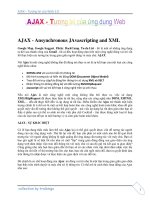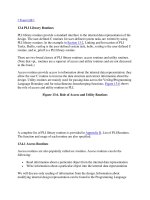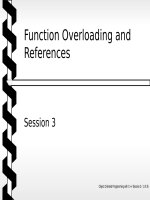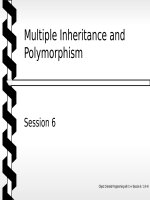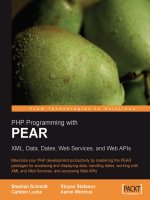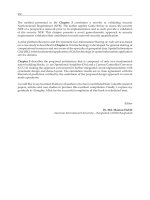PHP Programming with PEARXML, Data, Dates, Web Services, and Web APIs - Part 2 pdf
Bạn đang xem bản rút gọn của tài liệu. Xem và tải ngay bản đầy đủ của tài liệu tại đây (349.75 KB, 31 trang )
MDB2
[ 18 ]
Data Types
To address the issue of different database systems supporting different eld types,
MDB2 comes with its own portable set of data types. You can use MDB2's data types
and have the package ensure portability across different RDBMS by mapping those
types to ones that the underlying database understands.
The MDB2 data types and their default values are as follows:
$valid_types = array ( 'text' => '',
'boolean' => true,
'integer' => 0,
'decimal' => 0.0,
'float' => 0.0,
'timestamp' => '1970-01-01 00:00:00',
'time' => '00:00:00',
'date' => '1970-01-01',
'clob' => '',
'blob' => '',
)
More detailed information on the data types is available in the datatypes.html
document you can nd in the docs folder of your PEAR installation. You can also
nd this document on the Web, in the PEAR CVS repository:
/>Setting Data Types
In all the data retrieval methods that you just saw (query*(), fetch*(), get*())
you can specify the type of the results you expect and MDB2 will convert the values
to the expected data type. For example the query() method accepts an array of eld
data types as a second parameter.
$sql = 'SELECT * FROM people';
$types = array();
$result = $mdb2->query($sql, $types);
$row = $result->fetchRow();
var_dump($row);
Here the $types array was blank, so you'll get the default behavior (no data type
conversion) and all the results will be strings. The output of this example is:
array(2)
{
["id"] => string(1) "1"
["name"]=> string(5) "Eddie"
Chapter 1
[ 19 ]
}
But you can specify that the rst eld in each record is of type integer and the
second is text by setting the $types array like this:
$types = array('integer', 'text');
In this case you'll get:
array(2)
{
["id"]=> int(1)
["name"]=> string(5) "Eddie"
}
When setting the types, you can also use an associative array where the keys are the
table elds. You can even skip some elds if you don't need to set the type for them.
Some valid examples:
$types = array( 'id' => 'integer',
'name' => 'text'
);
$types = array('name'=>'text');
$types = array('integer');
Setting Data Types when Fetching Results
If you didn't set the data types during a query() call, it's still not too late. Before you
start fetching, you can set the types by calling the setResultTypes() method.
// execute query
$sql = 'SELECT * FROM people';
$result = $mdb2->query($sql);
// fetch first row without type conversion
$row = $result->fetchRow();
var_dump($row['id']);
// output is: string(1) "1"
// specify types
$types = array('integer');
$result->setResultTypes($types);
// all consecutive fetches will convert
// the first column as integer
MDB2
[ 20 ]
$row = $result->fetchRow();
var_dump($row['id']);
// output is: int(2)
Setting Data Types for get*() and query*()
All the get*() and query*() methods that you saw earlier in this chapter accept
data types as a second parameter, just like query() does.
You can set the data types parameter not only as an array $types =
array('integer'), but also as a string $types = 'integer'. This is convenient
when you work with methods that return one column only, such as getOne(),
queryOne(), getCol(), and queryCol(), but you should be careful when using it
for *All() and *Row() methods because the string type parameter will set the type
for all the elds in the record set.
Quoting Values and Identiers
The different RDBMS use different quoting styles (for example single quotes ' as
opposed to double quotes ") and also quote different data types inconsistently.
For example, in MySQL you may (or may not) wrap integer values in quotes, but for
other databases you may not be allowed to quote them at all. It's a good idea
to leave the quoting job to the database abstraction layer, because it "knows" the
different databases.
MDB2 provides the method quote() for quoting data and quoteIdentifier() to
quote database, table, and eld names. All the quotes MDB2 inserts will be the ones
appropriate for the underlying RDBMS. An example:
$sql = 'UPDATE %s SET %s=%s WHERE id=%d';
$sql = sprintf( $sql,
$mdb2->quoteIdentifier('people'),
$mdb2->quoteIdentifier('name'),
$mdb2->quote('Eddie'), // implicit data type
$mdb2->quote(1, 'integer') // explicit type
);
If you echo $sql in MySQL you'll get:
UPDATE `people` SET `name`='Eddie' WHERE id=1
In Oracle or SQLite the same code will return:
UPDATE "people" SET "name"='Eddie' WHERE id=1
Chapter 1
[ 21 ]
As you can see in the example above, quote() accepts an optional second parameter
that sets the type of data (MDB2 type) to be quoted. If you omit the second
parameter, MDB2 will try to make a best guess for the data type.
Iterators
MDB2 benets from the Standard PHP Library ( and
implements the Iterator interface, allowing you to navigate through query results
in a simpler manner:
foreach ($result as $row)
{
var_dump($row);
}
For every iteration, $row will contain the next record as an array. This is equivalent
to calling fetchRow() in a loop, like this:
while ($row = $result->fetchRow())
{
var_dump($row);
}
In order to benet from the Iterator implementation, you need to include the le
Iterator.php from MDB2's directory by using the loadFile() method:
MDB2::loadFile('Iterator');
Then when you call query(), you pass the name of the Iterator class as a fourth
parameter, like this:
$query = 'SELECT * FROM people';
$result = $mdb2->query($query, null, true, 'MDB2_BufferedIterator');
MDB2 comes with two Iterator classes:
MDB2_Iterator: This implements SPL's Iterator and is suitable to work
with unbuffered results.
MDB2_BufferedIterator: This extends MDB2_Iterator and implements the
SeekableIterator interface. When you work with buffered results (which
is the default in MDB2), it's better to use MDB2_BufferedIterator, because it
provides some more methods, like count() and rewind().
•
•
MDB2
[ 22 ]
Debugging
MDB2 allows you to keep a list of all queries executed in an instance, this way
helping you debug your application. To enable the debugging, you need to set the
debug option to a positive integer.
$mdb2->setOption('debug', 1);
Then you can get the collected debugging data at any point using:
$mdb2->getDebugOutput();
You can also set the option log_line_break, which species how the separate
entries in the debug output will be delimited. The default delimiter is a line break \n.
Take a look at the following example that sets the debug option and the line separator,
executes a few queries, and then draws an unordered list with the debug output.
$mdb2->setOption('debug', 1);
$mdb2->setOption('log_line_break', "\n\t");
$sql = 'SELECT * FROM people';
$result = $mdb2->query($sql);
$sql = 'SELECT * FROM people WHERE id = 1';
$result = $mdb2->query($sql);
$sql = 'SELECT name FROM people';
$result = $mdb2->query($sql);
$debug_array = explode("\n\t", trim($mdb2->getDebugOutput()));
echo '<ul><li>';
echo implode('</li><li>', $debug_array);
echo '</li></ul>';
This example will produce:
query(1): SELECT * FROM people
query(1): SELECT * FROM people WHERE id = 1
query(1): SELECT name FROM people
It's a good idea to reset the debug level to 0 when your application is in production,
so that you don't have the overhead of storing all executed queries in the debug log.
•
•
•
Chapter 1
[ 23 ]
MDB2 SQL Abstraction
There are a number of features and items of SQL syntax that are implemented
differently in the various database systems that MDB2 supports. MDB2 does its best
to wrap the differences and provide a single interface for accessing those features, so
that the developer doesn't need to worry about the implementation in the underlying
database system.
Sequences
Auto-increment elds are a convenient way to dene and update IDs as primary
keys to your tables. The problem is that not all RDBMS support auto increments. To
address this inconsistency, the concept of sequence tables is used in MDB2. The idea
is that MDB2 will create and maintain a new table (without you having to worry
about it) and will store and increment the last ID, which you can use later when
inserting into in the main table.
Let's assume that the table people, which was used in this chapter's examples, is
empty. Before you insert into this table, you need the next consecutive ID. For this
purpose you call the method nextId() to give you the new ID, like this:
$my_new_id = $mdb2->nextId('people');
Now $my_new_id has the value 1, and behind the scenes MDB2 will create a new
table called people_seq with one eld only, called sequence, and one row only,
containing the value 1. The next time you call $mdb2->nextId('people'), MDB2
will increment the value in people_seq and return 2 to you.
sequence
1
You're free to pass any identier as a parameter when calling nextId(). MDB2 will
append _seq to your identier and create a new table with that name, if one doesn't
already exist. Unless you have special needs, it helps code readability if you use an
identier that is the name of the main table you're inserting into.
While sequence is the default name of the eld in the sequence table, it can be
overwritten by setting the seqcol_name option, like this:
$mdb2->setOption('seqcol_name', 'id');
Additionally, the name of the sequence table can be customized by setting the
seqname_format option. Its default value is %s_seq, where %s is replaced by the
identier you pass to nextId().
MDB2
[ 24 ]
Setting Limits
In MySQL you can limit the number of records returned by a query by using LIMIT.
For example, the following query will give you only the rst two records:
SELECT * FROM people LIMIT 0, 2;
LIMIT is MySQL-specic, so it may be missing from other database systems or
implemented differently. To wrap all the differences and provide a common
interface for limiting results, MDB2 offers the setLimit() method. An example:
$sql = 'SELECT * FROM people';
$mdb2->setLimit(2);
$result = $mdb2->query($sql);
If you want to dene an offset (where to start when setting the limit), you specify the
offset value as a second parameter:
$mdb2->setLimit(2, 1);
Note that setLimit() will affect only the next query; any query after that will
behave as usual.
Another way to limit the results is by using the limitQuery() method from the
Extended module. Instead of rst setting the limit and then executing the query, you
do it with one method call. To get two records starting from offset 1, write:
$mdb2->loadModule('Extended');
$sql = 'SELECT * FROM people';
$result = $mdb2->limitQuery($sql, null, 2, 1);
Using limitQuery() doesn't affect the queries executed after that and it returns an
MDB2_Result object, just like query().
Replace Queries
MySQL supports the REPLACE statement in addition to UPDATE and INSERT. REPLACE
will update the records that already exist or perform an insert otherwise. Using
REPLACE directly will create portability issues in your application, which is why
MDB2 wraps this functionality in the replace() method. You call replace() by
providing the name of the table and an array of data about the records.
$fields=array ( 'id' => array ( 'value' => 6,
'key' => true
),
'name' => array ('value' => 'Stoyan'),
'family' => array ('value' => 'Stefanov'),
Chapter 1
[ 25 ]
'birth_date' => array ('value' => '1975-06-20')
);
$mdb2->replace('people', $fields);
As you can see, the data to be written to the table was set using the value keys. It
was also specied that the id is a key, so that (if using REPLACE directly is not an
option) MDB2 can check if a record with this ID already exists. If you have a key that
consists of several elds, set the 'key' => true index for all of them. Other array
elements you can use are:
type: to specify the MDB2 data type
null: (true or false) to specify whether the null value should be used,
ignoring the content in the value key
The replace() method will return the number of affected rows, just like exec()
does. Technically, the replace operation is an insert if the record doesn't exist or
otherwise a delete and then an insert. Therefore the replace() method will return 1
if the record didn't exist previously or 2 if an existing record was updated.
Sub-Select Support
You can pass an SQL query string to the subSelect() method. In this case, if the
database system supports sub-selects, the result will be the same query unchanged. If
sub-selects are not supported though, the method will execute the query and return
a comma-delimited list of the result values. It is important that the query you pass to
subSelect() returns only one column of results. Example:
// sub-select query string
$sql_ss = 'SELECT id FROM people WHERE id = 1 OR id = 2';
// the main query
$sql = 'SELECT * FROM people WHERE id IN (%s)';
// call subSelect()
$subselect = $mdb2->subSelect($sql_ss);
// update and print the main query
echo $sql = sprintf($sql, $subselect);
// execute
$data = $mdb2->queryAll($sql);
If sub-selects are supported, the echo statement above will output:
SELECT * FROM people WHERE id IN
(SELECT id FROM people WHERE id = 1 OR id = 2)
Otherwise you'll get:
SELECT * FROM people WHERE id IN (1, 2)
•
•
MDB2
[ 26 ]
Note that subSelect() is not a full sub-query replacement, it just emulates the so-
called non-correlated sub-queries. This means that your sub-selects and your main
query should be executable as stand-alone queries, so in your sub-query you cannot
refer to results returned by the main query, and vice-versa.
Prepared Statements
Prepared statements are a convenient and security-conscious method of writing to
the database. Again, not all database systems support prepared statements, so MDB2
emulates this functionality when it's not provided natively by the RDBMS. The idea
is to have the following:
A generic query with placeholders instead of real data that is passed to the
prepare() method
Some data about the records to be inserted, updated, or deleted
A call to execute() the prepared statement
The generic query may use unnamed or named placeholders, for example:
$sql = 'INSERT INTO people VALUES (?, ?, ?, ?)';
or
$sql = 'INSERT INTO people VALUES
(:id, :first_name, :last_name, :bdate)';
Then you call the prepare() method, which gives you an instance of the MDB2_
Statement_* class corresponding to the current database driver you're using:
$statement = $mdb2->prepare($sql);
If you use unnamed parameters (the question marks), you need to have your data as
an ordered array, like:
$data = array(
$mdb2->nextId('people'), 'Matt', 'Cameron', '1962-11-28'
);
And then you pass the data to the execute() method of the MDB2_Statement class:
$statement->execute($data);
Finally you release the resources taken:
$statement->free();
•
•
•
Chapter 1
[ 27 ]
Named Parameters
If you use named parameters in your generic query, you have the convenience of
using associative arrays when supplying data and not worrying about the order of
the parameters as you would in the case of unnamed parameters. The following is a
valid way to set data for a query with named parameters:
$data = array( 'first_name' => 'Jeff',
'last_name' => 'Ament',
'id' => $mdb2->nextId('people'),
'bdate' => '1963-03-10'
);
Binding Data
Another option for setting the data for a prepared statement is to use the
bindParam() method. Here's an example:
// prepare the statement
$sql = 'INSERT INTO people VALUES
(:id, :first_name, :last_name, :bdate)';
$statement = $mdb2->prepare($sql);
// figure out the data
$id = $mdb2->nextId('people');
$first_name = 'Kirk';
$last_name = 'Hammett';
$bdate = '1962-11-18';
// bind the data
$statement->bindParam('id', $id);
$statement->bindParam('first_name', $first_name);
$statement->bindParam('last_name', $last_name);
$statement->bindParam('bdate', $bdate);
// execute and free
$statement->execute();
$statement->free();
One thing to note about bindParam() is that it takes a reference to the variable
containing the data. If you're inserting several new records, therefore calling
execute() multiple times, you don't have to call bindParam() for every execute().
Just calling it once and then changing the data variables is enough (in this case $id,
$first_name, $last_name, and $bdate). But if you want to store the actual value
when binding, you can use the method bindValue() instead of bindParam().
MDB2
[ 28 ]
Another way to supply data before executing a prepared statement is to use the
bindParamArray() method, which allows you to bind all parameters at once. In the
code from the previous example you can replace the four calls to bindParam() with
one call to bindParamArray():
$array_to_bind = array('id' => $id,
'first_name' => $first_name,
'last_name' => $last_name,
'bdate' => $bdate
);
$statement->bindParamArray($array_to_bind);
Execute Multiple
Once you have prepared a statement, you can insert multiple rows in one shot by
using executeMultiple(). This method is also in the Extended MDB2 module, so
you need to load it rst. The data you specify must be in a multidimensional array
where each element at the top level of the array is one record.
$sql = 'INSERT INTO people VALUES (?, ?, ?, ?)';
$statement = $mdb2->prepare($sql);
$data = array(
array($mdb2->nextId('people'), 'James', 'Hetfield',
'1969-06-06'),
array($mdb2->nextId('people'), 'Lars', 'Ulrich',
'1968-02-02')
);
$mdb2->loadModule('Extended');
$mdb2->executeMultiple($statement, $data);
$statement->free();
Auto Prepare
Instead of writing a generic query and then preparing a statement, you can have
the autoPrepare() method do it for you. You supply only the name of the table,
an array of eld names, and the type of the query—insert, update, or delete. If you
do an update or delete, you can also give the WHERE condition as a string or an array
containing different conditions, which MDB2 will concatenate with AND for you. An
insert example would be:
$mdb2->loadModule('Extended');
$table = 'people';
$fields = array('id', 'name', 'family', 'birth_date');
$statement = $mdb2->autoPrepare($table, $fields,
MDB2_AUTOQUERY_INSERT);
Chapter 1
[ 29 ]
This way you'll get an MDB2_Statement object created from a generic query that
looks like this:
INSERT INTO people (id, name, family, birth_date) VALUES (?, ?, ?, ?)
If you want an update statement, you can do something like this:
$mdb2->loadModule('Extended');
$table = 'people';
$fields = array('name', 'family', 'birth_date');
$where = 'id = ?';
$statement = $mdb2->autoPrepare($table, $fields,
MDB2_AUTOQUERY_UPDATE, $where);
The code above will prepare this type of generic query:
UPDATE people SET name = ?, family = ?, birth_date = ? WHERE id = ?
Internally, autoPrepare() uses the buildManipSQL() method, which basically does
all the work of creating the generic query, but doesn't call prepare() once the query
is built. You might nd this method useful in cases when you just need a query and
do not intend to use prepared statements. Here's how you can delete all the records
in the table with last names starting with S and s:
$mdb2->loadModule('Extended');
$sql = $mdb2->buildManipSQL(
'people',
false,
MDB2_AUTOQUERY_DELETE,
'family like "s%"');
echo $mdb2->exec($sql);
Auto Execute
The autoExecute() method is similar to autoPrepare() but it also executes the
prepared statement. The difference in the parameters passed is that the array of
elds should be an associative array containing bothe the eld names and the data to
be inserted or updated.
$mdb2->loadModule('Extended');
$table = 'people';
$fields = array ( 'id' => $mdb2->nextId('people'),
'name' => 'Cliff',
'family' => 'Burton',
'birth_date' => '1962-02-10'
);
$result = $mdb2->autoExecute($table, $fields, MDB2_AUTOQUERY_INSERT);
MDB2
[ 30 ]
Transactions
If transactions are supported by your RDBMS, using them is very good practice
to keep your data in a consistent state, should an error occur in the middle of the
process of writing several pieces of data to one or more tables.
You begin by checking whether transactions are supported by your RDBMS and then
you initiate a new transaction with a call to beginTransaction(). Then you start
executing the different queries that comprise your transaction. After every query
you can check the result and if you nd it's a PEAR_Error, you can roll back (undo)
the transaction and all previously executed queries within it. Otherwise you commit
(nalize) the transaction. Before the calls to rollback() or commit(), you need to
check if you really are in transaction, using the inTransaction() method.
if ($mdb2->supports('transactions'))
{
$mdb2->beginTransaction();
}
$result = $mdb2->exec('DELETE FROM people WHERE id = 33');
if (PEAR::isError($result))
{
if ($mdb2->inTransaction())
{
$mdb2->rollback();
}
}
$result = $mdb2->exec('DELETE FROM people WHERE id =
invalid something');
if (PEAR::isError($result))
{
if ($mdb2->inTransaction())
{
$mdb2->rollback();
}
}
elseif ($mdb2->inTransaction())
{
$mdb2->commit();
}
Note that if transactions are not supported by your RDBMS, MDB2 will not emulate
this functionality, so it is your responsibility to keep the data in a consistent state.
Chapter 1
[ 31 ]
MDB2 Modules
When looking at some of the examples earlier in this chapter, you've already seen
how the idea of modularity is built into MDB2. The main purpose is to keep the base
functionality lightweight and then include more functionality on demand, using the
loadModule() method.
Earlier in the chapter, the Extended module was loaded like this:
$mdb2->loadModule('Extended');
After this call you have access to all the methods that the Extended module provides,
such as all the get*() methods. The methods are accessible through the extended
property of the $mdb2 instance:
$mdb2->extended->getAssoc($sql);
In addition to that, in PHP5, due to the object overloading functionality, you can
access the methods directly as methods of the $mdb2 instance:
$mdb2->getAssoc($sql);
In this chapter PHP5 was assumed, so all the calls to the module methods benet
from object overloading and are called using this short notation.
Yet another way to access the module's methods is by prexing them with the short
name of the module ex (for "Extended"). This is also PHP5-only.
$mdb2->exGetAssoc($sql);
And nally, you can specify a custom property name to load the module into (works
in both PHP 4 and 5):
$mdb2->loadModule('Extended', 'mine');
$mdb2->mine->getAssoc($sql);
The full list of currently available MDB2 modules is as follows (short access names
given in brackets):
Extended (ex): You already have an idea of some of the methods available in
the Extended module. This module is the only one unrelated to the different
database drivers and its denition le (Extended.php) lies in the root MDB2
directory, not in the Drivers directory. This module is dened in the MDB2_
Extended class, which inherits the MDB2_Module_Common class.
Datatype (dt): Contains methods for manipulating and converting MDB2 data
types and mapping them to types that are native to the underlying database.
•
•
MDB2
[ 32 ]
Manager (mg): Contains methods for managing the database structure
(schema), like creating, listing, or dropping databases, tables, indices, etc.
Reverse (rv): Methods for reverse engineering a database structure.
Native (na): Any methods that are native to the underlying database are
placed here.
Function (fc): Contains wrappers for useful functions that are implemented
differently in the different databases.
Let's see a few examples that use some of the modules.
Manager Module
Using the Manager module you have access to methods for managing your database
schema. Let's see some of its methods in action.
Create a Database
Here's an example that will create a new blank database:
$mdb2->loadModule('Manager');
$mdb2->createDatabase('test_db');
Create a Table
You can use the Manager module to recreate the table people that was used in the
earlier examples in this chapter. This table had four elds:
id: An unsigned integer primary key that cannot be null
name: A text eld, like VARCHAR(255) in MySQL
family: Same type as name
birth_date: A date eld
To create this table you use the createTable() method, to which you pass the table
name and an array containing the table denition.
$definition = array ( 'id' => array ( 'type' => 'integer',
'unsigned' => 1,
'notnull' => 1,
'default' => 0,
),
'name' => array ( 'type' => 'text',
'length' => 255
),
'family' => array ( 'type' => 'text',
•
•
•
•
•
•
•
•
Chapter 1
[ 33 ]
'length' => 255
),
'birth_date' => array ( 'type' => 'date'
)
);
$mdb2->createTable('people', $definition);
Alter Table
Let's say that after the table was created, you decide that 255 characters are too
much for one name. In this case you'll need to set up a new denition array and call
alterTable(). The new denition array used for modications is broken down into
the following keys:
name: New name for the table
add: New elds to be added
remove: Fields to be dropped
rename: Fields to rename
change: Fields to modify
Here's how to modify the name eld to store only a hundred characters:
$definition = array(
'change' => array(
'name' => array(
'definition' => array(
'length' => 100,
'type' => 'text',
)
),
)
);
$mdb2->alterTable('people', $definition, false);
If you set the third parameter of alterTable() to true, MDB2 will not execute the
changes, but will only check if they are supported by your DBMS.
Constraints
The id eld was meant to be the primary key, but so far it isn't. For this purpose you
can use the createConstraint() method, which accepts the table name, the name
we chose for the constraint, and the array containing the constraint denition.
$definition = array ( 'primary' => true,
'fields' => array ( 'id' => array())
•
•
•
•
•
MDB2
[ 34 ]
);
$mdb2->createConstraint('people', 'myprimekey', $definition);
Note that MySQL will ignore the myprimekey name of the
constraint, because it requires the primary key to always be
named PRIMARY.
Now we can specify that the name plus the family name should be unique:
$definition = array('unique' => true,
'fields' => array('name' => array(),
'family' => array(),
)
);
$mdb2->createConstraint('people', 'unique_people',
$definition);
On second thoughts, different people sometimes have the same names, so let's drop
this constraint:
$mdb2->dropConstraint('people', 'unique_people');
Indices
If there will be a lot of SELECTs on the birth_date eld, you can speed them up by
creating index on this eld.
$definition = array('fields' => array('birth_date' => array(),) );
$mdb2->createIndex('people', 'dates', $definition);
Note that by default MDB2 will add a _idx sufx to all your indices and constraints.
If you want to modify this behavior, set the idxname_format option:
$mdb2->setOption('idxname_format', '%s'); // no suffix
Listings
In the Manager module you have also a lot of methods to get information
about a database, such as listDatabases(), listUsers(), listTables(),
listTableViews(), and listTableFields().
Chapter 1
[ 35 ]
Function Module
The Function module contains some methods to access common database functions,
such as referring to the current timestamp, and concatenating or getting partial
strings. If you want to access the current timestamp in your statements, you can use
the now() method and it will return you the means to get the timestamp in a way
that is native for the currently underlying database system.
$mdb2->loadModule('Function');
echo $mdb2->now();
This will output CURRENT_TIMESTAMP when using MySQL and datetime('now')
when using SQLite.
now() accepts a string parameter (with values date, time, and timestamp) that
species if you want the current date, time, or both.
If you wish to concatenate strings in your statements in a database-agnostic way, you
can use the concat() method and pass an unlimited number of string parameters to
it. For extracting substrings, you have the substring() method. Here's an example
that uses both methods:
$mdb2->loadModule('Function');
$sql = 'SELECT %s FROM people';
$first_initial = $mdb2->substring('name', 1, 1);
$dot = $mdb2->quote('.');
$all = $mdb2->concat($first_initial, $dot, 'family');
$sql = sprintf($sql, $all);
$data = $mdb2->queryCol($sql);
echo $sql;
print_r($data);
The print_r() from this code will produce:
Array (
[0] => E.Vedder
[1] => M.McCready
[2] => S.Gossard
)
The echo $sql; line will print a different result, depending on the database driver
you use. For MySQL it would be:
SELECT CONCAT(SUBSTRING(name FROM 1 FOR 1), '.', family) FROM people
MDB2
[ 36 ]
Using the Oracle (oci8) driver, you'll get:
SELECT (SUBSTR(name, 1, 1) || '.' || family) FROM people
In this example only the rst character from the value in the name eld was extracted.
Then it was concatenated with the dot symbol and the full value of the family eld.
Note that it was necessary to quote the dot in order for it to be treated as a string and
not a eld name.
Reverse Module
If you want to get information about the table people that was used in the examples
in this chapter, you can call the tableInfo() method:
$mdb2->loadModule('Reverse');
$data = $mdb2->tableInfo('people');
If you print_r() the result, you'll get something like:
Array( [0] => Array ( [table] => people
[name] => id
[type] => int
[length] => 11
[flags] => not_null primary_key
[mdb2type] => integer
)
[1] => Array ( [table] => people
[name] => name
[type] => char
[length] => 100
[flags] =>
[mdb2type] => text
)
)
The real magic about the tableInfo() method is that it can return information on
the elds based on a query result, not just a table. Let's say you have one more table
phones in your database that stores phone numbers of the people from the people
table and it looks like this:
id person_id Phone
1 1 555-666-7777
2 1 555-666-7788
Chapter 1
[ 37 ]
You can execute a query that joins the two tables and when you get the result, you can
pass it to tableInfo():
$mdb2->loadModule('Reverse');
$sql = 'SELECT phones.id, people.name, phones.phone ';
$sql.= ' FROM people ';
$sql.= ' LEFT JOIN phones ';
$sql.= ' ON people.id = phones.person_id ';
$result = $mdb2->query($sql);
$data = $mdb2->tableInfo($result);
Now if you print_r() what tableInfo() returns, you'll get an array that describes
the three elds selected in the JOIN statement—id, name, and phone:
Array (
[0] => Array ( [table] => phones
[name] => id
[type] => int
[length] => 11
[flags] => primary_key
[mdb2type] => integer
)
[1] => Array ( [table] => people
[name] => name
[type] => char
[length] => 100
[flags] =>
[mdb2type] => text
)
[2] => Array ( [table] => phones
[name] => phone
[type] => char
[length] => 20
[flags] =>
[mdb2type] => text
)
)
Extending MDB2
MDB2 is easy to tweak by playing with its numerous setup options, but it's also
highly extensible. For example, you can wrap the query results in your custom
classes, when you execute a query or fetch data. You can create your own debug
handler, provide your own Iterator implementation, and nally, you can add new
MDB2
[ 38 ]
functionality to the package by creating new modules in addition to the existing
ones. In this section you'll see the necessary steps for creating custom functionality.
Custom Debug Handler
You already know that you can set the debug option to a positive integer like this:
$mdb2->setOption('debug', 1);
Then at any time you can get a list of executed queries like this:
$mdb2->getDebugOutput();
You can provide your own custom debug handler to collect the list of queries.
The debug handler can be a function or a class method—basically anything that
qualies as a valid PHP callback pseudo-type ( Let's
create a new class that will be responsible for collecting debug information and then
printing it. The custom functionality in this example will be that our data collection
will keep a running counter of how many times each query has been executed. This
can be useful when you do performance testing on a larger application. Often in an
application you put small pieces of functionality in different classes and methods
and then simply call these methods when you need them, without worrying how
exactly they work, which is the beauty of OOP. So it may happen that some methods
that do database work are called more often then you thought and perform repeating
tasks. Using the custom debugger in the following example, you can identify and
optimize such cases.
class Custom_Debug_Class
{
// how many queries were executed
var $query_count = 0;
// which queries and their count
var $queries = array();
// this method is called on every query
function collectInfo(&$db, $scope, $message, $is_manip =
null)
{
$this->query_count++;
@$this->queries[$message]++;
}
// print the log
function dumpInfo()
{
Chapter 1
[ 39 ]
echo 'Total queries in this page: ';
echo $this->query_count;
// sort descending
arsort($this->queries);
echo '<pre>';
print_r($this->queries);
echo '</pre>';
}
}
To see the custom debug handler in action, you need to instantiate the newly created
class, set the MBD2 debug handler callback, execute a few queries (one of them is
executed twice), and then print the results.
$my_debug_handler = new Custom_Debug_Class();
$mdb2->setOption('debug', 1);
$mdb2->setOption('debug_handler', array($my_debug_handler,
'collectInfo'));
$sql = 'SELECT * FROM people';
$result = $mdb2->query($sql);
$sql = 'SELECT * FROM people WHERE id = 1';
$result = $mdb2->query($sql);
$my_debug_handler->dumpInfo();
The result of this will be:
Total queries in this page: 3
Array
(
[SELECT * FROM people]=>2
[SELECT * FROM people WHERE id = 1]=>1
)
During the development phase of your application you can even register
dumpInfo() to be called automatically at the end of each script using:
register_shutdown_function(array($my_debug_handler,
'dumpInfo'));
Here's an idea for monitoring performance in your application's MySQL queries
with MDB2's help. You can create (and register to be executed on a script shutdown)
MDB2
[ 40 ]
a new method in your custom debug class that will take only the SELECT queries
and re-run them by prexing them with the EXPLAIN statement. Then you can do
some automated checks to nd suspicious queries that are not using appropriate
indices. You can nd more on the EXPLAIN statement at />doc/refman/5.0/en/explain.html.
Custom Fetch Classes
As you know already, you can have different fetch modes when you retrieve the
data from a query result—associative array, ordered list, or object. When you use the
object fetch mode (MDB2_FETCHMODE_OBJECT), an instance of PHP's standard class
(stdClass) is created for every row (by simply casting the array result to an object).
This allows you to access the eld data as object properties, for example $row->name
or $row->id.
MDB2 gives you the means to customize this functionality by providing your
own custom fetch class. Every row in the result set will be passed as an array to
the constructor of the custom class. Let's create a simple class that mimics what
stdClass will give you, only it converts the eld with name id to an integer.
class My_Fetch_Class
{
function __construct($row)
{
foreach ($row as $field => $data)
{
if ($field == 'id')
{
$data = (int)$data;
}
$this->{$field} = $data;
}
}
}
To test the class, you need to set the fetch mode to MDB2_FETCHMODE_OBJECT, and the
option fetch_class to be the name of the new class.
$mdb2->setFetchMode(MDB2_FETCHMODE_OBJECT);
$mdb2->setOption('fetch_class', 'My_Fetch_Class');
The same result can be achieved directly with the call to setFetchMode().
$mdb2->setFetchMode(MDB2_FETCHMODE_OBJECT, 'My_Fetch_Class');
Chapter 1
[ 41 ]
If you execute a query like this:
$sql = 'SELECT * FROM people WHERE id=1';
$data = $mdb2->queryRow($sql);
and then var_dump() the result, you'll get:
object(My_Fetch_Class)#3 (2)
{
["id"]=>
int(1)
["name"]=>
string(5) "Eddie"
}
Also note that in the core MDB2 package there exists a class called MDB2_Row that
does pretty much what the custom class example above does, only it doesn't convert
elds named id to an integer. If you make your custom fetch classes extend MDB2_
Row, you can benet from what it provides and build upon it.
Custom Result Classes
As you know already, once you execute an SQL statement with query(), you get an
object of the appropriate MDB2_Result class. If you're using MySQL, the result class
would be MDB2_Result_mysql and it will extend the common functionality provided
by MDB2_Result_Common, which in turn extends MDB2_Result. MDB2 provides
you the means to extend and customize the result classes, in other words replace or
extend MDB2_Result_* with your own classes.
What you need to do is:
Create your custom result class
Make sure its denition is included
Pass its name as an MDB2 option
Let's create a class called MyResult and make it extend the out-of-the-box MDB2_
Result_mysql class, so that you can benet from the existing functionality. To this
class, let's add a simple method that demonstrates the feature:
class MyResult extends MDB2_Result_mysql
{
function newResultMethod()
{
echo 'I am MyResult::newResultMethod()';
•
•
•
MDB2
[ 42 ]
// $this->db is your current MDB2 instance
// in case you need it
}
}
Then, to make this class available when executing queries, let’s pass its name as
an option:
$mdb2->setOption('buffered_result_class', 'MyResult');
Now you can execute a query and call the new custom method on its result:
$sql = 'SELECT * FROM people';
$result = $mdb2->query($sql);
$result->newResultMethod();
As you saw above, the option buffered_result_class was set. This is because the
default behavior for MDB2 is to use buffered queries. You can change this by setting:
$mdb2->setOption('result_buffering', false);
In this case, when you're working with unbuffered results, if you want to use the
custom result class, you will need to set the result_class option, as opposed to the
buffered_result_class one:
$mdb2->setOption('result_class', 'MyResult');
If you want to create custom result classes that are database-specic, you can postx
their names with the name of the MDB2 database driver (for example MyResult_
mysql) and you can use a placeholder for the driver name when setting the custom
class option:
$mdb2->setOption('result_class', 'MyResult_%s');
MDB2 will replace the %s placeholder with the name of the database driver used for
the current MDB2 instance.
Let's take a look at another, slightly more advanced example. The idea is to create
a new method in the custom result class that will calculate the average age of the
people matched by any query. Here's the code for the new custom class—MyResult2.
class MyResult2 extends MDB2_BufferedResult_mysql
{
function getAverageAge()
{
$current_row = $this->rowCount(); // where are we
$this->seek(); // rewind
$total_ts = 0; // sum of all birth date timestamps

